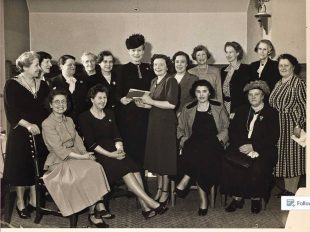
In 2016, a team of writers from Hansard began work on a research project on female MPs. They were tasked by colleagues in the Curator’s Office and the Parliamentary Archives to find statistical data on women elected since 1918 and produce biographical snapshots of each MP.
This work forms the basis for the blog series Women MPs, 1918-1997. We caught up with Portia Dadley who heads up the House of Commons Hansard Writing Team about the blog and why the work profiling women MPs is so important to educate and inspire the next generation.
Showcasing women MPs
In our blog series we give an overview of women MPs from 1918 to 1997, focusing on their struggles and successes. We look at the campaigns and cross-party alliances that enabled them to forge their place in Parliament.
Some of the MPs we blog about are famous, but many have been forgotten.
We aim to provide a short, sharp account of their lives and parliamentary careers so that their achievements are brought into focus. With each successive blog post we will build an accurate picture of women in Parliament that can be used as a springboard for further research.
Celebrating women in Parliament
When I stood up and asked questions affecting women and children, social and moral questions, I used to be shouted at for 5 or 10 minutes at a time. That was when they thought that I was rather a freak, a voice crying in the wilderness.
- Nancy Astor
The composition of the House of Commons has changed dramatically since Constance Markievicz and Nancy Astor became the first women to be elected as MPs in 1918 and 1919.
Women MPs are no longer considered ‘freaks’, but they are still outnumbered by men in Parliament. In 2020, women account for 220, or roughly a third, of a total of 650 MPs. We want to tell the stories of these women who had the courage and commitment to serve as MPs in the 20th century, to celebrate their achievements, and hopefully inspire more women to work in politics.
What does Hansard do?
Hansard is a behind-the-scenes operation. Our team of reporters and editors produce accurate transcripts of MPs’ speeches in Parliament. It’s a bit like a play in reverse: we turn the words spoken by MPs in Parliament into text.
We work to tight deadlines—we usually have a three-hour target for publishing reports of speeches made in the Chamber on Parliament’s website. We’re nifty researchers, checking anything from dialect words and place names to obscure quotes.
Our impartiality and ability to capture the flavour of MPs’ speeches have proved invaluable when it comes to writing concise and balanced biographies. We can provide an objective overview of the political landscape without losing sight of the character and originality of the women we are profiling.
The first woman to be appointed as a permanent Hansard reporter
An important MP for Hansard is Conservative Irene Ward, who backed Hansard reporter Jean Winder in her fight for equal pay. In 1944, Jean Winder became the first woman to be appointed as a permanent Hansard reporter, but was paid less than her male counterparts. Her case was taken up by Ward, who thought it “rank injustice” and raised it in the Chamber.
On 2 August 1951, she told the House that although it “was run on the basis of equal pay…there is one woman on the Hansard staff…Mrs Winder, who has not got equal pay.”
In January 1954, Winder won parity, and the Treasury agreed that she should be paid “as if she were a male reporter”.
Tips for women wanting to get into politics
Have courage—don’t give up. We uncovered countless inspiring stories of determination, mutual support and compassion.
Conservative MP Katharine Stewart-Murray and Independent MP Eleanor Rathbone worked across party lines to raise concerns about the rise of fascism, and travelled together to Spain during the civil war to observe events at first hand.
Labour MP Leah Manning undertook humanitarian work in Spain in the same period, and was instrumental in the evacuation of 4,000 children from Bilbao, which was under attack from the Nationalist army.
Did you know....
- Until 1997, women never constituted more than 10% of MPs—until the late 1980s the proportion was always below 5%.
- Until the 1997 election, only 10 women had ever served as Cabinet Ministers.

Recent Comments